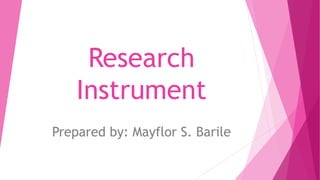
Research instrument
- 1. Research Instrument Prepared by: Mayflor S. Barile
- 2. RESEARCH INSTRUMENTS These are the fact finding strategies. They are the tools for data collection They include Questionnaire, Interview, and Observation.
- 3. Characteristics of a Good Research Instrument 1. The Instrument must be valid and reliable 2. It must be based upon the Conceptual framework. 3. It must gather data suitable for and relevant to the research topic. 4. It must gather data would test the hypotheses or answer the questions under investigation
- 4. Characteristics of a Good Research Instrument 5. It should be free from all kinds of bias. 6. It must contain clear and definite directions to accomplish it. 7. It must be accompanied by a good cover letter. 8. It must be accompanied, if possible, by a letter of recommendation from a sponsor.
- 6. 1. Interviews It is an interaction in which oral questions are posed by the interviewer to elicit oral response from the interviewee. a. Structured Interviews The Structured Interviews are formal because, sets of questions known as interview questionnaire are posed to each interviewee visited and the responses are recorded on a standardized schedule.
- 7. b. Unstructured Interview The Unstructured Interview is the less formal type in which although sets of questions may be used, the interviewer freely modifies the sequence of questions, changes the wording and sometimes explains them or adds to them during the interaction. c. Non-Directive Interview The Non-Directive Interview or the unguided gives excessive freedom for the respondent to express his or her ideas subjectively and spontaneously as she chooses or is able to. d. Focus Interview Focus Interview as the name suggests, focuses on the respondent’s subjective responses and experience on the subject matter to elicit more information.
- 8. 2. Observation. is one of the very important methods for obtaining comprehensive data in qualitative research especially when a composite of both oral and visual data become vital to the research. a. Participant Observer: In this type of observation the researcher lives as a member of the subjects of the study while observing and keeping notes of the attributes of the subject that is being researched so that he can directly experience, the phenomenon being studied.
- 9. b. Non-Participant Observer: In this approach the researcher does not live as a member of the subjects of the study. The researcher watches the subjects of his or her study, with their knowledge of his status as a researcher, but without taking an active part in the situation under study.
- 10. 3. Questionnaire This is a data collection instrument mostly used in normative surveys. This is a systematically prepared form or document with a set of questions deliberately designed to elicit responses from respondents or research informants for the purpose of collecting data or information. • It is a form of inquiry document, which contains a systematically compiled and well organized series of questions intended to elicit the information which will provide insight into the nature of the problem under study. • It is a form that contains a set of questions on a topic or group of topics designed to be answered by the respondent.
- 11. Advantages Disadvantages Easy to construct Distribution is easy and inexpensive Responses are easy to tabulate Respondent’s replies are free Confidential information may be given freely Respondents can fill out the questionnaire at will. Respondents can give more accurate replies. Cannot be used to illiterate person Respondents may not return the filled up copies of the questionnaire. Respondents give a wrong information. Respondents may leave some or many questions un-answered. Number of choices may be so limited that the respondents may be forced to select responses that are not his actual choice.
- 12. Steps in Preparing a Questionnaire 1. Doing library search. 2. Talking to knowledgeable people. 3. Mastering the guidelines. 4. Writing the questionnaire. 5. Editing the questionnaire. 6. Rewriting the Questionnaire. 7. Pretesting the questionnaire
- 13. TYPES OF QUESTIONS ASKED IN SURVEY QUESTIONNAIRES
- 14. A. ACCORDING TO FORM 1. THE FREE-ANSWER TYPE – also called the open form, open- ended, subjective, unrestricted, essay, and unguided response type. 2. THE GUIDED RESPONSE TYPE – This is also called the closed form or restricted type. a. Recall Type – the replies are recalled. b. Recognition Type – the possible responses are given and the respondents selects his answer. 1. Dichotomous- There are only two questions and one is selected 2. Multiple Choice – Only one answer is chosen from those given as options. 3. Multiple responses – Two or more options may be chosen
- 15. B. ACCORDING TO THE KIND OF DATA ASKED FOR 1. DESCRIPTIVE (VERBAL) DATA 2. QUANTIFIED (NUMERICAL) DATA 3. INTENSITY OF FEELING, EMOTION OR ATTITUDE 4. DEGREE OF JUDGMENT 5. UNDERSTANDING 6. REASONING
- 16. GUIDELINES IN FORMULATING OF QUESTIONS FOR A QUESTIONNAIRE 1. Make all directions clear 2. Use correct grammar 3. Make all questions unequivocal 4. Avoid asking biased questions. 5. Objectify the responses. 6. Relate all questions to the topic under study.
- 17. 7. Create categories or classes for approximate answer. 8. Word carefully or avoid questions that deal with confidential or embarrassing information. 9. Explain and illustrate difficult questions 10. State all questions affirmatively 11. Make the respondents anonymous.